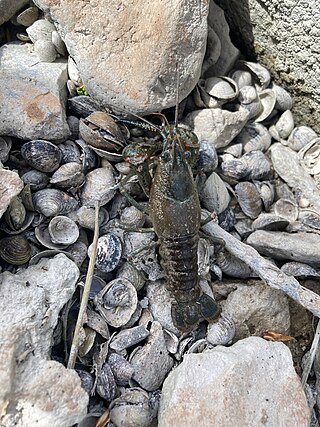
Orconectes is a genus of cave dwelling freshwater crayfish, endemic to suitable habitats in the eastern United States. Surface dwelling species, formerly categorised here, were moved to Faxonius in 2017.
Faxonius cooperi, the Flint River crayfish, is a species of crayfish in the family Cambaridae. It is endemic to Alabama and Tennessee in the United States. The common name refers to the Flint River, where the original specimens were found.

Faxonius deanae, the Conchas crayfish is a species of crayfish in the family Cambaridae. It is endemic to the United States. The common name refers to the Conchas Lake, where the original specimens were found.
Orconectes incomptus is a species of crayfish in the family Cambaridae. It is endemic to Tennessee. It is also known as the Tennessee cave crayfish.
Faxonius marchandi, the Mammoth Spring crayfish, is a species of crayfish in the family Cambaridae. It is endemic to Missouri and Arkansas in the United States.
Faxonius menae, the Mena crayfish, is a species of crayfish in the family Cambaridae. It is endemic to Oklahoma and Arkansas in the United States. The specific epithet and common name both refer to Mena, Arkansas, where the original specimens were found.
Faxonius saxatilis is a species of crayfish in the family Cambaridae. It is endemic to tributaries of the Kiamichi River, Le Flore County, Oklahoma. Its common name is Kiamichi crayfish.
Faxonius stannardi, the Little Wabash crayfish, is a species of crayfish in the family Cambaridae. It is endemic to Illinois. The common name refers to the Little Wabash River, where the original specimens were found.
Faxonius wrighti, the Hardin crayfish, is a species of crayfish in the family Cambaridae. It is endemic to the United States. The common name refers to Hardin County, Tennessee, where the original specimens were found.

Orconectes australis, the southern cave crayfish, is a species of crayfish in the Cambaridae family found in Alabama and Tennessee. Ages of 176 years have been claimed for O. australis, though this was reduced to ≤22 years in a 2012 study.

Faxonius obscurus is a species of crayfish in the family Cambaridae. It is native to the northeastern United States, where it occurs in Maryland, New York, Ohio, Pennsylvania, Virginia, and West Virginia. It is an introduced species in adjacent regions, including Massachusetts, Vermont, and Ontario in Canada. It is known commonly as the Allegheny crayfish and the obscure crayfish.

Faxonius virilis is a species of crayfish known as the virile crayfish, northern crayfish,eastern crayfish, and lesser known as the lake crayfish or common crawfish. Faxonius virilis was reclassified in August 2017, and the genus was changed from Orconectes to Faxonius. It is native to the central United States, east to tributaries of Lake Erie, Lake Ontario, Lake Champlain and the St. Lawrence River in New York and to much of Canada.
Faxonius maletae, sometimes called the Kisatchie painted crayfish or Kisatchie painted crawfish, is a species of crawdad in the Cambaridae family. The specific epithet maletae is in honor of the discoverer's wife, author Maleta M. Walls, who helped collect many of the original specimens. It was originally described as a subspecies of Orconectes difficilis, but later elevated to full species status. The common name refers to the Kisatchie National Forest, near where the original specimens were found in Bayou Santabarb.
Orconectes packardi, the Appalachian cave crayfish, is a species of crayfish in the family Cambaridae. It is endemic to Kentucky, where it is found in 16 caves in four southeastern counties in the Cumberland River basin.

Orconectes sheltae, the Shelta Cave crayfish, is a small, freshwater crayfish endemic to Alabama in the United States. It is a cave-dwelling species known from only one cave, Shelta Cave in Madison County, Alabama. This cave is also home to O. australis and Cambarus jonesi.
Orconectes barri, the Cumberland Plateau cave crayfish, is a species of crayfish in the family Cambaridae. It is native to Kentucky and Tennessee in the United States, where it is found in nine caves on the Cumberland Plateau.
Orconectes inermis, the Northern cave crayfish, is a troglomorphic freshwater crayfish native to Kentucky and Indiana in the United States.
Faxonius stygocaneyi, the Caney Mountain cave crayfish, is a small, freshwater crayfish endemic to Missouri in the United States. It is a cave-dwelling species known from only one cave, Mud Cave in Ozark County, Missouri. This cave is Protected as part of the Caney Mountain Conservation Area, which covers 7,899 acres (3,197 ha) of public land administered by the Missouri Department of Conservation.
Orconectes inermis testii, known as the unarmed crayfish, is one of two subspecies of the northern cave crayfish, along with Orconectes inermis inermis.

![]() Media related to Orconectes pellucidus at Wikimedia Commons
Media related to Orconectes pellucidus at Wikimedia Commons






